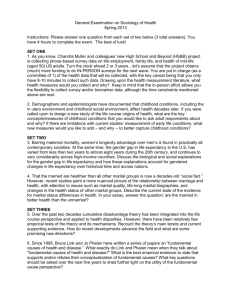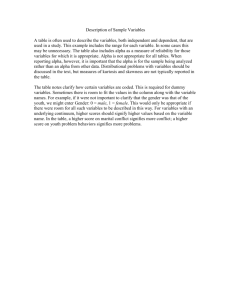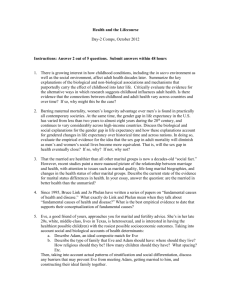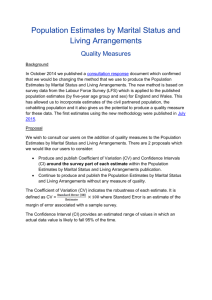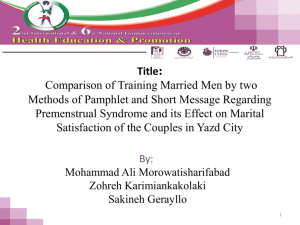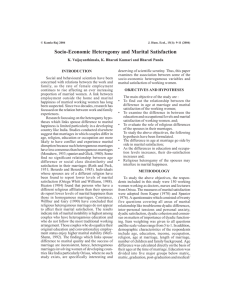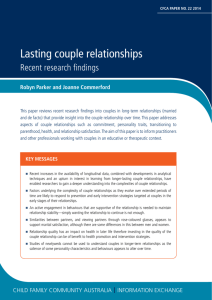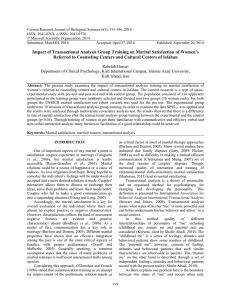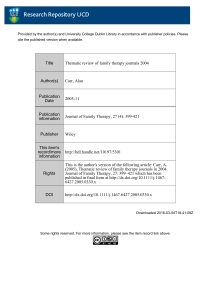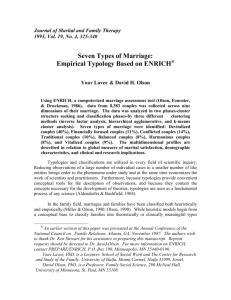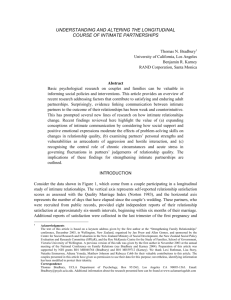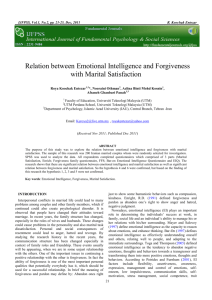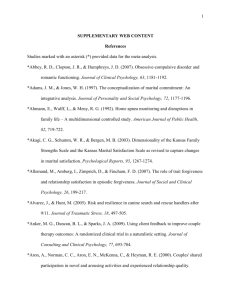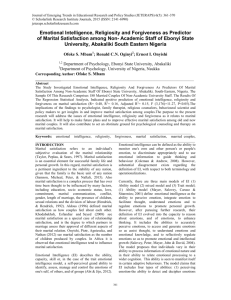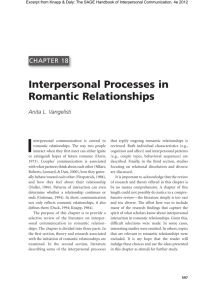putting research to work for military families
advertisement
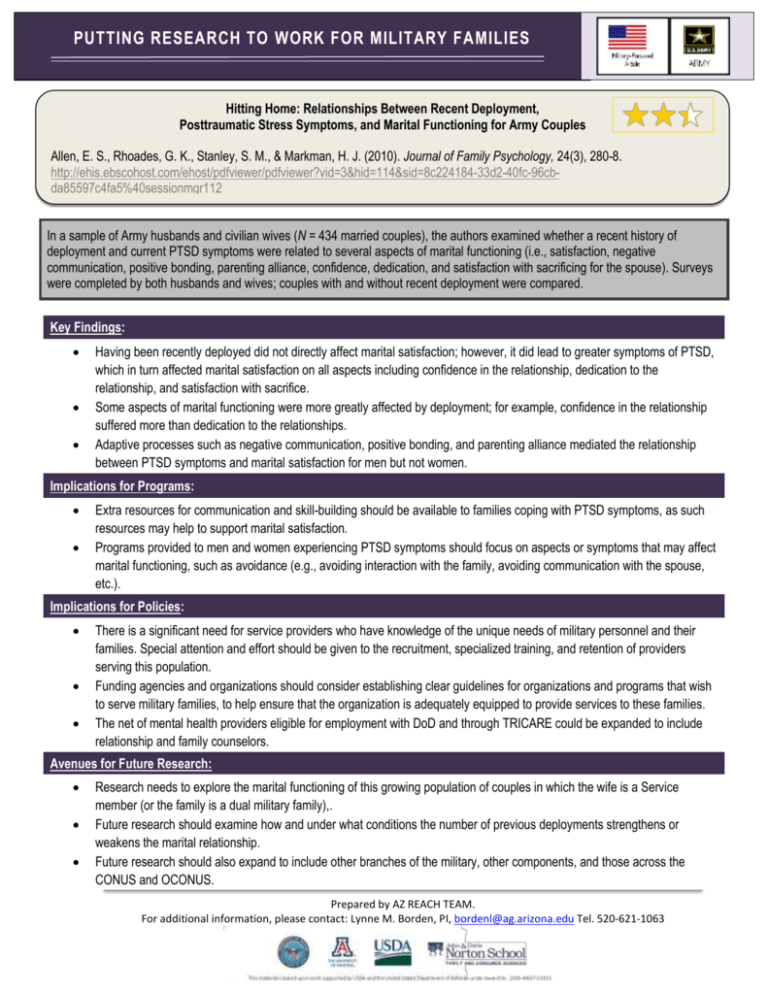
PUTTING RESEARCH TO WORK FOR MILITARY FAMILIES Hitting Home: Relationships Between Recent Deployment, Posttraumatic Stress Symptoms, and Marital Functioning for Army Couples Allen, E.\ S., Rhoades, G. K., Stanley, S. M., & Markman, H. J. (2010). Journal of Family Psychology, 24(3), 280-8. http://ehis.ebscohost.com/ehost/pdfviewer/pdfviewer?vid=3&hid=114&sid=8c224184-33d2-40fc-96cbda85597c4fa5%40sessionmgr112 In a sample of Army husbands and civilian wives (N = 434 married couples), the authors examined whether a recent history of deployment and current PTSD symptoms were related to several aspects of marital functioning (i.e., satisfaction, negative communication, positive bonding, parenting alliance, confidence, dedication, and satisfaction with sacrificing for the spouse). Surveys were completed by both husbands and wives; couples with and without recent deployment were compared. Key Findings: Having been recently deployed did not directly affect marital satisfaction; however, it did lead to greater symptoms of PTSD, which in turn affected marital satisfaction on all aspects including confidence in the relationship, dedication to the relationship, and satisfaction with sacrifice. Some aspects of marital functioning were more greatly affected by deployment; for example, confidence in the relationship suffered more than dedication to the relationships. Adaptive processes such as negative communication, positive bonding, and parenting alliance mediated the relationship between PTSD symptoms and marital satisfaction for men but not women. Implications for Programs: Extra resources for communication and skill-building should be available to families coping with PTSD symptoms, as such resources may help to support marital satisfaction. Programs provided to men and women experiencing PTSD symptoms should focus on aspects or symptoms that may affect marital functioning, such as avoidance (e.g., avoiding interaction with the family, avoiding communication with the spouse, etc.). Implications for Policies: There is a significant need for service providers who have knowledge of the unique needs of military personnel and their families. Special attention and effort should be given to the recruitment, specialized training, and retention of providers serving this population. Funding agencies and organizations should consider establishing clear guidelines for organizations and programs that wish to serve military families, to help ensure that the organization is adequately equipped to provide services to these families. The net of mental health providers eligible for employment with DoD and through TRICARE could be expanded to include relationship and family counselors. Avenues for Future Research: Research needs to explore the marital functioning of this growing population of couples in which the wife is a Service member (or the family is a dual military family),. Future research should examine how and under what conditions the number of previous deployments strengthens or weakens the marital relationship. Future research should also expand to include other branches of the military, other components, and those across the CONUS and OCONUS. Prepared by AZ REACH TEAM. For additional information, please contact: Lynne M. Borden, PI, bordenl@ag.arizona.edu Tel. 520-621-1063 PUTTING RESEARCH TO WORK FOR MILITARY FAMILIES Background Information Methodology: 434 married couples, in which the husband was Active Duty Army Service member and stationed at Fort Campbell, KY, were surveyed about their PTSD symptoms and marital satisfaction. The data were analyzed using a multivariate regression model. This article focuses on Active Duty Army couples. Participants: In terms of age, men were approximately 28 years on average (SD=5.6), and women were 27, on average (SD=6.0). 61% of the couples were both White, non-Hispanic; Ethnic compositions of the samples were: Men: 71% White, non-Hispanic, 13% Hispanic, 9% African American, 1% American Indian/Alaska Native, 1% Asian, 1% Hawaiian or Pacific Islander, 5% Multiracial; Women: 73% White, non-Hispanic, 10% Hispanic, 9% African American, 2% American Indian/Alaska Native, 1% Asian, 1% Hawaiian or Pacific Islander, 4% Multiracial Limitations: The sample may not be representative of all military couples as it only includes couples in which the husband is Active Duty Army and the wife is civilian, and they are stationed at Fort Campbell, KY. Participants self-selected into the study based on the opportunity to be enrolled in a marital focused intervention. Thus, participants in this sample are likely oversampled for marital problems, and possibly more motivated to seek assistance. Participants may have tried to answer in a socially acceptable fashion, rather than responding completely honestly. Assessing Research that Works Research Design and Sample The design of the study (e.g., research plan, sample, recruitment) used to address the research question was.... Research Methods The research methods (e.g., measurement, analysis) used to answer the research question was... Implications The implications of this research to programs, policies and the field are… Limitations The limitations of this study are… Quality Rating: Questionable () Excellent () Appropriate () Limited () ☐ ☒ ☐ Excellent () Appropriate () Limited () ☒ ☐ ☐ Excellent () Appropriate () Limited () ☐ ☒ ☐ Excellent Minor Limitations () Appropriate Few Limitations () Limited Questionable Several Limitations Many/Severe Limitations () ☐ ☒ () ☐ ☐ Quality Rating: Questionable () ☐ Quality Rating: Questionable () ☐ Quality Rating: ☐ Overall Quality Rating Prepared by AZ REACH TEAM. For additional information, please contact: Lynne M. Borden, PI, bordenl@ag.arizona.edu Tel. 520-621-1063
